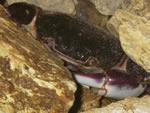During the visit
The Learning Story board – stages on the ELC learning pathway
| Planning – where did we start? In the classroom | The learning experience – handling information At the New Zealand Marine Studies Centre (NZMSC) | |
| Exploring broad understandings | Collecting information | Processing information |
|
Crabs |
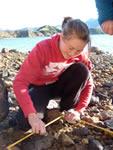 |
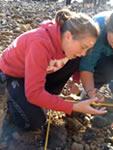 |
| In the classroom we looked at what they already knew about crabs (identified external structures), looked at the scientific language that would be used during the visit (matching words with definitions), and discussed some example experiments (exemplars). We also unpacked the achievement standard so that the students knew exactly what was required for achieved, merit or excellence. | Study of the shore crab and its niche. Students practised ways to handle and sex them. They looked at crab behaviours and responses to different stimuli and discussed the ethics of experimenting with these animals. Experiments were set up to look at feeding behaviours under different conditions and desiccation rates. They discussed how to form a hypothesis and the practicalities of doing an investigation. What sample size do we use? What are the dependent and independent variables? How do we control variables? | First milestone: End of day one. Students had to discuss the hypothesis for their own experiment with the teacher and the ELC educator (Steve). Students had to submit a list of equipment they would require for day two. |
| Developing | Collecting information | Collecting information |
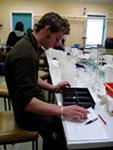 |
 |
 |
| On day two the students collected their equipment and set up their experiments. Second milestone:
| One of the hardy students braved the cold wet weather on day two. "I designed the experiment myself with a little direction from my classmate. It was only when we were going out on the shore did I realise that others were doing shore work and that maybe we could work together and help each other collect the data required." Another student wanted to know the oxygen level of the water. "I have never used an oxygen meter before, but now I am confident that I am reading it properly. Half crabs would be exposed to a change in oxygen on the seashore because they are found in tidal pools and in pools of water under rocks." |
| Processing information | Developing | Collecting information |
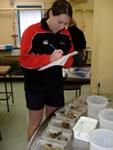 |
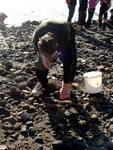 |
 |
| This student was continually making predictions as she carried out her investigation. She learned from experience where the crabs were likely to be, due to the size of the rocks in the area. Another student discussed her results with the rest of the class very confidently. She noticed she had an obvious trend: The more oxygen the crabs had, the faster they turned over. She compared results with another student (who was looking at feeding rates at different oxygen levels) and she is finding a similar trend. | Students used the results from day two to adjust their experiments on day three. "Tomorrow I will repeat the experiment and do the extremes again. I did not notice much difference with the middle values so I may reduce those treatments and just test one middle value." One student didn't notice any trends in his results at the end of day two. "When I repeat my experiment tomorrow, I will reverse the order of salinity treatments to see if fatigue might be affecting the turnover rate." Another student left her experiment running overnight to see if the crabs would respond differently when given more time, under dark conditions and through two tidal cycles. The results were more conclusive and showed a defined preference for higher salinities. Based on those results, she set up the experiment under dark conditions on day three. | The student who didn't notice trends on day two noticed clearer trends on day three. "They were turning over quicker in the lower salinity water. They may be more stressed in the low salinity and are trying to get out. My friend is looking at feeding rate and salinity so I will compare my results with his." The student who left her experiment to run overnight observed, "It is working much better in the dark although I am having the same problem with the clumping behaviour. I have increased the number of crabs in the tank to try to overcome this. It seems to take time for the crabs to move. If I had more time I could let the experiment run for a longer period." |
What did we do with what we found out – interpretation
| Processing | Developing | Communicating findings |
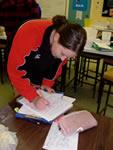 |
 |
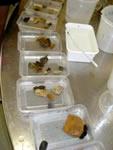 |
| Third milestone:
| As one student worked with the crabs, the more confident she became and the more questions she wanted to answer. "We found a crab that was really soft and mushy and there was a dead crab beside it. We had no idea that it had moulted and that the dead crab might be its empty shell. I want to know more about that. "What happens to the crab babies? Why are there not millions and millions of crabs when there are so many eggs? How long do they live? How long can they stay out of water?" | On their return to school, students had to complete a full scientific report. The reports included details of the methodology behind the experiments, the data fully analysed and presented, conclusions in relation to the hypothesis, consideration of possible error, and using charts, graphs, diagrams and photographs as appropriate. These reports were presented for assessment for an achievement standard, Biology 3.1. They were assessed by the teacher, who graded them and provided feedback to the students. |
Back in the classroom
Reflecting and evaluating
Student 1 was very clear that she needed to be in the environment to learn. "It is much better than being in the classroom. It is better seeing the animal in its natural environment. I liked it being an intensive course where you are just concentrating on one thing. At home you are trying to do biology with all your other subjects and sport. Here you can just work on one thing and get it right." Anita needed to refer back to Steve when writing her report. He helped her work through an issue that raised itself after she got back to school.
Student 2 had learned a lot about the experimental process. "I now know there is a lot of stuff that goes on in setting up and doing an experiment. You have to be so meticulous with everything you do. You have to control all the elements, otherwise you are sabotaging your own experiment!"
Student 3 was positive about the course. "The most important thing I learned was about experimental design – you must be able to repeat your findings. And you need a large range of data for a good conclusion. The live animals and hands-on nature of the programme were the best parts – much better than sitting at a computer or in class." Jeremy found it easier to learn from the real thing rather than looking at diagrams in books.
Student 4 thought the intensive nature of the course worked. "The environment was much more stimulating than school. It was great to have the crabs and all the equipment. Steve was really helpful. I would rather do it all in one go, rather than spreading it out over a week or two in the classroom. No worry about forgetting certain things that you did in your experiment and the time limit meant that there was no option to put it off until later."
Where to next?
Student 1 discovered a passion for the environment. "I want to know more about beach preservation. You have no idea how many crabs live there and how varied they are. And some are in berry and they need our protection."
Student 2 was a very focused student and had clear ideas of where she wanted to go next. "It was really interesting learning about the crabs. Before I knew nothing about crabs, but now I have a good understanding of them and I am happy to pick them up! I would be keen to come back if we could look at a different species."
Student 3 "I would like to study crabs for longer (maybe a year) to get more data and a wider range to look at."
Student 4 wanted more hands-on experience with animals and biology in a real scientific environment rather than a classroom. "Now I am really interested in osmosis. I would like to continue investigating their reaction to different salinities if I had more time and equipment. I still have lots of questions about the first experiment that I started. I think they do have reaction to light. If I had more time and additional equipment I would like to try to do an experiment to test my first hypothesis."


